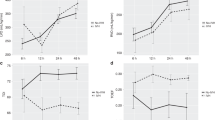Abstract
To treat respiratory distress syndrome, surfactant is currently delivered via less invasive surfactant administration (LISA) or INtubation SURfactant Extubation (INSURE). The aim of this study was to compare the effect of the two delivery methods of surfactant on cerebral autoregulation. Near infrared spectroscopy monitoring was carried out to detect cerebral oxygen saturation (ScO2), and the mean arterial blood pressure (MABP) was simultaneously recorded. Of 44 preterm infants included, the surfactant was administrated to 22 via LISA and 22 via INSURE. The clinical characteristics, treatments and outcomes of the infants showed no significant differences between the two groups. The correlation coefficient of ScO2 and MABP (r ScO2-MABP) 5 min before administration was similar in the two groups. During surfactant administration, r ScO2-MABP increased in both groups (0.44±0.10 to 0.54±0.12 in LISA, 0.45±0.11 to 0.69±0.09 in INSURE). In the first and second 5 min after instillation, r ScO2-MABP was not significantly different from baseline in the LISA group, but increased in the first 5 min after instillation (0.59±0.13, P=0.000 compared with the baseline in the same group) and recovered in the second 5 min after instillation (0.48±0.10, P=0.321) in the INSURE group. There were significant differences in the change rates of r ScO2-MABP between the two groups during and after surfactant administration. Our results suggest that cerebral autoregulation may be affected transiently by surfactant administration. The effect duration of LISA is shorter than that of INSURE (<5 min in LISA vs. 5–10 min in INSURE).
Similar content being viewed by others
References
Blennow M, Bohlin K. Surfactant and noninvasive ventilation. Neonatology, 2015,107(4):330–336
Klebermass-Schrehof K, Wald M, Schwindt J, et al. Less invasive surfactant administration in extremely preterm infants: impact on mortality and morbidity. Neonatology, 2013,103(4):252–258
Bao Y, Zhang G, Wu M, et al. A pilot study of less invasive surfactant administration in very preterm infants in a Chinese tertiary center. BMC Pediatr, 2015,15(1):1–6
Herting E. Less invasive surfactant administration (LISA) -ways to deliver surfactant in spontaneously breathing infants. Early Hum Dev, 2013,89(11):875–880
Göpel W, Kribs A, Ziegler A, et al. Avoidance of mechanical ventilation by surfactant treatment of spontaneously breathing preterm infants (AMV): an open-label, randomised, controlled trial. Lancet, 2011,378(9803):1627–1634
Kanmaz HG, Erdeve O, Canpolat FE, et al. Surfactant administration via thin catheter during spontaneous breathing: randomized controlled trial. Pediatrics, 2013,131(2):e502–e509
Vutskits L. Cerebral blood flow in the neonate. Paediatr Anaesth, 2014,24(1):22–29
Soul JS, Hammer PE, Tsuji M, et al. Fluctuating pressure-passivity is common in the cerebral circulation of sick premature infants. Pediatr Res, 2007,61(4):467–473
Back SA. Cerebral white and gray matter injury in newborns: New insights into pathophysiology and management. Clin Perinatol, 2014,41(1):1–24
Volpe JJ. Hypoxic-ischemic encephalopathy: biochemical and physiological aspects. Neurology of the newborn. 5th ed, 2008. Philadelphia: Saunders Elsevier, 247–324
Lemmers PM, Toet M, van Schelven LJ, et al. Cerebral oxygenation and cerebral oxygen extraction in the preterm infant: the impact of respiratory distress syndrome. Exp Brain Res, 2006,173(3):458–467
Albertine KH. Brain injury in chronically ventilated preterm neonates: collateral damage related to ventilation strategy. Clin Perinatol, 2012,39(3):727–740
Promjunyakul N, Lahna D, Kaye JA, et al. Characterizing the white matter hyperintensity penumbra with cerebral blood flow measures. Neuroimage Clin, 2015,8:224–229
Caicedo A, Alderliesten T, Naulaers G, et al. A new framework for the assessment of cerebral hemodynamics regulation in neonates using NIRS. Adv Exp Med Biol, 2016,876: 501–509
Munro MJ, Walker AM, Barfield CP. Hypotensive extremely low birth weight infants have reduced cerebral blood flow. Pediatrics, 2004,114(6):1591–1596
Greisen G. Autoregulation of cerebral blood flow in newborn babies. Early Hum Dev, 2005,81(5):423–428
Göpel W, Kribs A, Härtel C, et al. Less invasive surfactant administration is associated with improved pulmonary outcomes in spontaneously breathing preterm infants. Acta Paediatr, 2015,104(3):241–246
Vesoulis ZA, Liao SM, Trivedi SB, et al. A novel method for assessing cerebral autoregulation in preterm infants using transfer function analysis. Pediatr Res, 2016,79(3):453–459
Stammwitz A, von SK, Bucher HU, et al. Can the assessment of spontaneous oscillations by near infrared spectrophotometry predict neurological outcome of preterm infants. Adv Exp Med Biol, 2016,876:521–531
Author information
Authors and Affiliations
Corresponding author
Additional information
This project was supported by a grant from the Medical and Health Science and Technology Project of Guangzhou (No. 20151A011027).
Rights and permissions
About this article
Cite this article
Li, Xf., Cheng, Tt., Guan, Rl. et al. Effects of different surfactant administrations on cerebral autoregulation in preterm infants with respiratory distress syndrome. J. Huazhong Univ. Sci. Technol. [Med. Sci.] 36, 801–805 (2016). https://doi.org/10.1007/s11596-016-1665-9
Received:
Revised:
Published:
Issue Date:
DOI: https://doi.org/10.1007/s11596-016-1665-9




